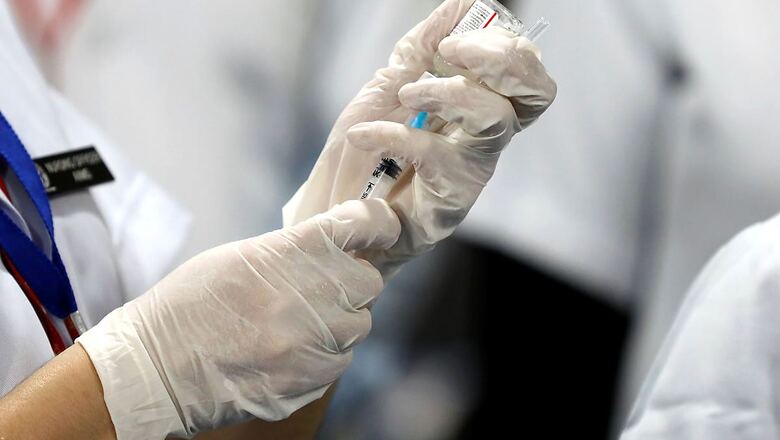
views
India completed 150 days of its Covid vaccination drive on June 14. The country, so far, has inoculated 25.90 crore people, with an average 17.26 lakh doses administered per day. Going by this rate, it will take approximately 78 weeks, or 18 months, for all the adult Indian population to get partially vaccinated.
How the vaccination drive has proceeded
The central government started its nationwide inoculation exercise on January 16 with emergency use approvals to two vaccines: Covishield, developed by AstraZeneca-Oxford University, and Covaxin, India’s indigenously developed Covid vaccine by Hyderabad-based Bharat Biotech.
The government chose a rational foundation to adopt the target base of the population. The first priority was to vaccinate the healthcare workers (HCW) directly engaged in the Covid treatment process, and the frontline workers (FLW), the connecting links between the society, industry and administration, like the police persons, journalists, drivers and courier boys for delivering essential services. The next phases were to add more vulnerable groups to the drive one by one, like the 60+ population, the 45+ population with comorbidities, the whole 45+ population, and so on.
First phase
The first phase of vaccination started on January 16 this year with healthcare workers. It was further expanded in February, adding frontline workers to the drive. As per the Government of India estimates, the total target base was three crore beneficiaries: one crore healthcare workers and two crore frontline workers. A total of 1,43,01,266 vaccine doses were administered during this phase.
Second phase
India began its mass vaccination drive with the second phase on March 1. The targeted beneficiary base in this phase was 27 crore, as per the government estimates. This included the 60+ population age group and those above 45 years of age with comorbidities. As per Census 2011 projections, India has 13.79 crore people above 60 years of age. That leaves 13.21 crore people with comorbidities in the targeted beneficiary group. Phase 2 of the vaccination drive administered 5,08,16,630 doses, or an average 16.93 lakh vaccine shots a day.
Third phase
The third phase of vaccination was opened up on April 1 for the entire 45+ population base, or 34.51 crore people, as per Census 2011 projection. And the drive that month administered the maximum number of doses so far: 8,98,71,739 shots, or 29.95 lakh doses per day.
Fourth phase
After the disastrous second Covid wave, the inoculation exercise was opened for all adults of the country, or the population base that is above 18 years of age, i.e., 94.02 crore individuals, as per the Census 2011 projection, in the fourth phase of the drive.
From 80,000 cases on April 1, India hit the globally highest-ever single-day record of 4.14 lakh cases on May 6. The active caseload burden went over 37 lakh, combined with a sharp decline in recovery rate from more than 97% to less than 80%. The death rate was consistently high in the range of 3,000-4,000 fatalities on many days. It crossed the highest-ever figure of 6,148 deaths on June 9. The country, ultimately, was forced to open the drive for its entire adult population eligible for vaccination.
Till the third phase of the vaccination process, the whole exercise was under the control of the Government of India. From May onwards, the Centre introduced a liberalised vaccination policy to decentralise the drive as demanded by the governments of some states. The exercise now saw a mixed-mode of operation where the central government took responsibility for the free vaccine doses to HCW, FLW and the 45+ population base, while state government and private hospitals had the responsibility of vaccinating the population base between 18 and 44 years of age.
Difficulties cropped up
But while the target population base expanded over 2.7 times, the manufacturing capacity available in the country remained the same, around 7.5 crore doses a month. So, while India needed at least 25 crore vaccine doses in May to scale up on the base it made in April, it could just administer 6,10,57,003 doses overall, or 20.35 lakh doses a day.
Red flags were raised on vaccine shortage. State governments and union territories said they were not able to get vaccine doses from the manufacturers directly as their production pipeline was already choked with the orders from the central government. They only started getting direct vaccine supply from the second fortnight of the month. Many of them tried to float global tenders, but international manufacturers like Pfizer and Moderna said they would deal only with the Government of India. And even if they agreed, it would take some time before the vaccines could be made available in the country, while the demand was immediate.
There were other problems like different vaccine prices for the central and the state governments, vaccine hesitancy in small towns and rural India, the problem of the government’s Co-WIN portal being available only in English and a digital divide between urban, small-town and rural India, and the high vaccine wastage rate in some states.
When the state governments realised these limitations, they had no other option but to go back to the Centre, urging it to take the vaccine drive under its control again.
Fifth phase – a comeback month?
Phase 4 of vaccination, which was supposed to be a joint effort between the central and the state governments, could only administer 6,10,57,003 shots in May, a significant 32% drop by the scale achieved in May. Will this month see a comeback?
The central government has decided to take over the reins of the inoculation exercise again from June 21, assuring that 12 crore vaccine doses would be available this month. Serum Institute of India (SII), the Covishield manufacturer, has also said that it is ramping up its manufacturing capacity and would be able to produce and supply around 10 crore doses this month. Another two crore doses would be made available by Bharat Biotech and Russia’s Sputnik V vaccine that is being imported. So, in theory, by the end of this month, the country would be able to vaccinate 12 crore people more, or see an average of 40 lakh doses being administered a day.
Read all the Latest News, Breaking News and Coronavirus News here.




















Comments
0 comment